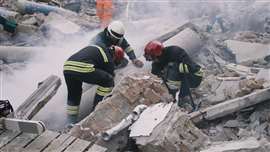Why our buildings must be more resilient in the future
14 September 2023
Every year, disasters linked to natural and climate hazards strike, and infrastructure suffers. Jan Przydatek of Lloyd’s Register Foundation, explains why resilience needs to be embedded into the built environment.
 Image: Frame Stock Footage/Shutterstock
Image: Frame Stock Footage/Shutterstock
On 6 February 2023, Turkey was hit by a 7.8 magnitude earthquake – likely to be one of the deadliest this decade.
It had a devastating death toll surpassing 49,000, and much of the disaster region’s infrastructure was either destroyed or deemed unsafe.
In the eastern city of Malatya, apartments built just a year before were completely destroyed. This large-scale devastation was a result of a number of factors leading to inadequate infrastructure, yet the warning signs couldn’t have been clearer for a region that regularly experiences major tremors.
Turkey’s example of inadequate preparation is not unique.
In May 2023, for example, the UK Health Security Agency deemed England’s built environment unfit to face extreme heatwaves, with the Committee on Climate Change finding it wholly unprepared to face the effects of global warming.
In disasters of such scale, the economic consequences are felt for years, with rebuilding requiring a huge amount of investment.
However, making changes to infrastructure plans today could minimise the impact of these extreme events in the future – both in terms of cost and the harm they inflict.
Building Resilience into Infrastructure
$94 trillion - this is the estimated amount of new funded infrastructure required to meet increasing global building needs by 2040 due to urbanisation and climate change.
The task ahead is incredibly challenging, but complacency could lead to far graver consequences.
This is where initiatives like Resilience Rising come in.
A partner of Lloyd’s Register Foundation, the organisation is a global platform for collective impact that strives to achieve systemic resilience and build momentum toward a safe, resilient, and sustainable future for all.
Resilience Rising achieves this through working closely with a broad constellation of partners, such as the International Coalition for Sustainable Infrastructure (ICSI), which mobilises the engineering community to address climate change and improve the resilience and sustainability of critical infrastructure.
However, an urgent shift in attitude is needed to make this a reality.
Making the right decisions early on in an infrastructure plan can help stabilise buildings, giving confidence that foundations laid can absorb and recover from shocks and stresses caused by climate change and natural disasters.
Championing change
The learnings from developing resilient infrastructure can also be applied at an organisational level.
Part of the solution is appointing a board-level resilience champion. This individual would be responsible for ensuring culture change and adoption of resilience strategies throughout an organisation.
Having a resilience champion who sits on the board of a company ensures leadership and that guidance from the top is filtered throughout the organisation, with resilience embedded into daily practices.
To build resilience into buildings, companies need to invest in resilient teams who have the tools to absorb and rebuild from internal shocks, too.
Every company will face a crisis at some point – it’s inevitable. That’s why taking a holistic approach to resilience throughout a company identifies weaknesses and vulnerabilities at different points. In turn, this establishes a clear line of communication and understanding of responsibilities in times of crisis.
Highlighting the importance of resilient infrastructure, The Engineering Leadership Group (ELG) launched its new manifesto calling for decisive and radical action from all infrastructure stakeholders.
Advocating for future buildings that leave no one behind, the manifesto focuses on new developments and retrofitting existing builds. That’s why the ELG argues that to enable net zero projects, global funding investment needs to be unlocked, with a focus on resilience embedded at every level of the decision-making process.
Is Building Back Better Possible?
Climate change demands urgent action and we must face up to the stark reality we find ourselves facing.
No part of the world is exempt, and we are all responsible for what happens next.
In many places across the world, critical infrastructure is past its original design life. Properly funding these changes is paramount to any success and requires companies and charities to come together.
The key safety challenges that exist in current infrastructure include:
- Materials and their degradation: Understanding the long-term performance of new materials.
- Measurement and sensing: Understanding the condition of an asset using data collection.
- Simulation and modelling: Understanding how assets will perform in their operating environments.
- Systems, complexity, and risk: Assuring that a system will maintain its function through system performance.
- Knowledge transfer: Transferring knowledge from industrial sectors to plug the skills gap.
Identifying architecture that needs retrofitting is part of the solution but building with resilience in mind, negates the need for this entirely.
Seeing homes and buildings reduced to rubble has become sadly too common. Why? Because instead of fixing the root cause of infrastructure problems, clean-ups have become accepted as an unavoidable part of managing natural disasters.
But it doesn’t have to be this way. By becoming more resilient, we can get ahead of the curve and make sure no one is left behind in the fight for sustainable and structurally sound buildings.
Jan Przydatek, is director of technologies at Lloyd’s Register Foundation, a charity that helps protect property and supports engineering-related research, with a stated mission of ‘engineering a safer world’.
STAY CONNECTED



Receive the information you need when you need it through our world-leading magazines, newsletters and daily briefings.
CONNECT WITH THE TEAM







